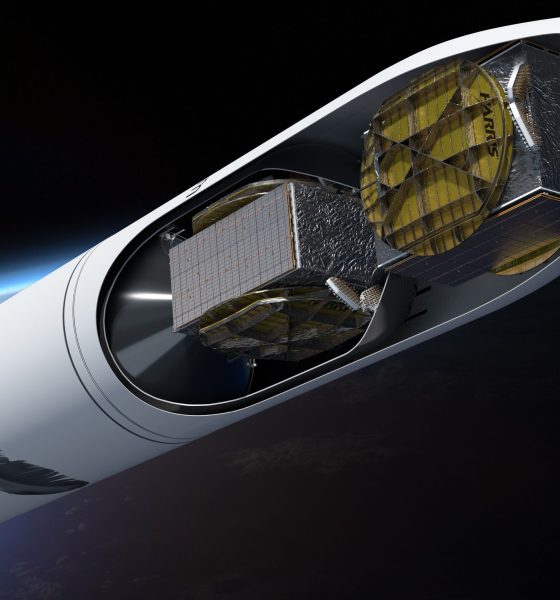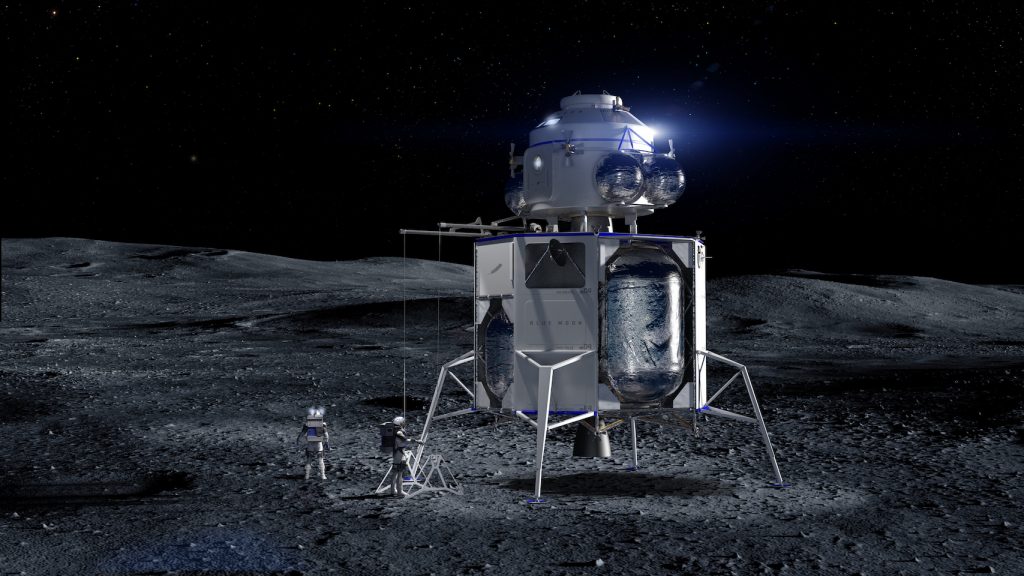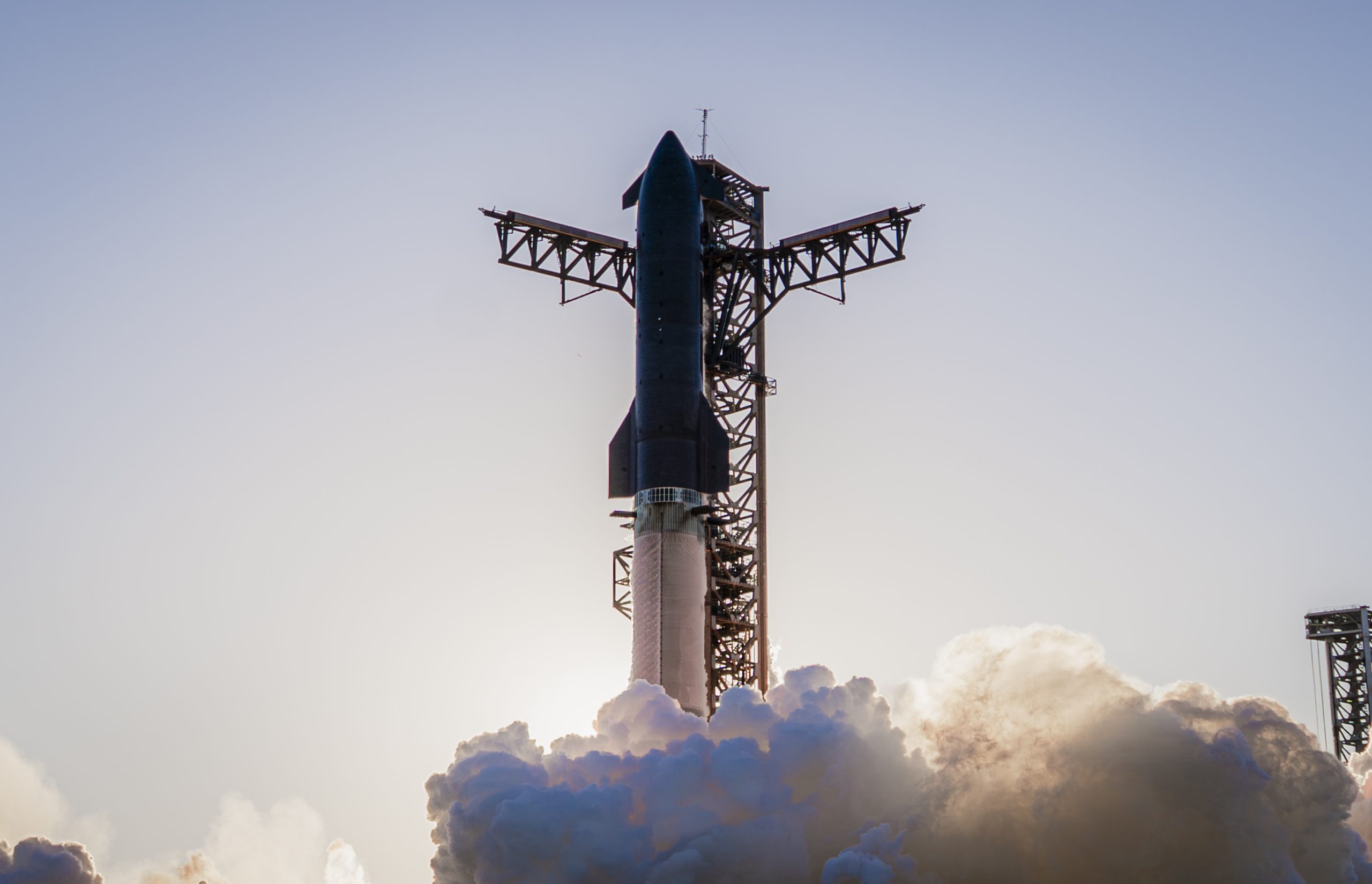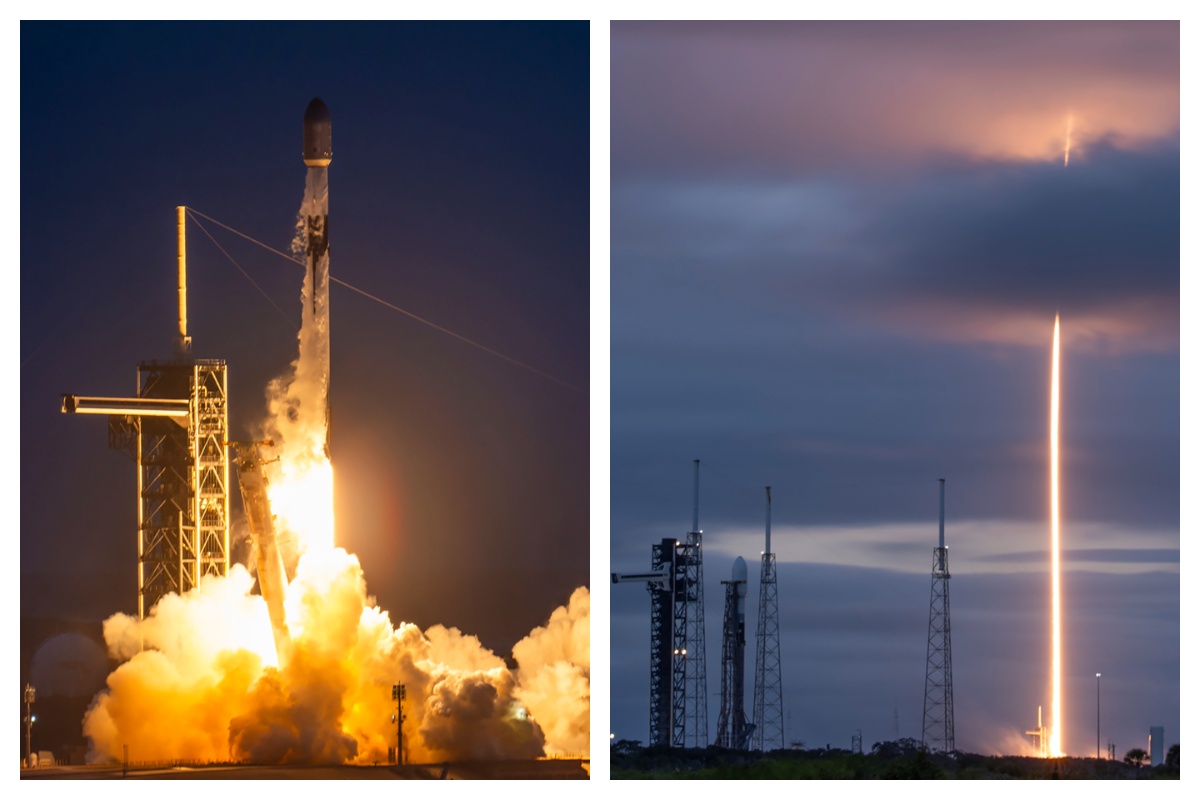

News
Blue Origin teases first New Glenn rocket prototype at Blue Moon lander event
In May 2019, Blue Origin unveiled plans to build and launch “Blue Moon” lunar landers. Five months later, founder Jeff Bezos has announced a proposal for NASA’s Artemis Moon lander program that would augment Blue Moon with hardware from aerospace stalwarts Lockheed Martin, Northrop Grumman, and Draper to land astronauts on the Moon in the 2020s.
On top of that, Bezos also revealed the first unequivocal confirmation that Blue Origin has begun building full-scale prototype hardware for its ambitious New Glenn orbital launch vehicle – in this case, half of a massive carbon fiber payload fairing.
In a press release posted to the company’s website, Blue Origin’s Chief Executive Officer, Bob Smith, stated that “national challenges call for a national response. We are humbled and inspired to lead this deeply committed team that will land NASA astronauts on the Moon.” The national team will be managed with Blue Origin as the principal contractor and “[combine] our partners’ heritage with our advance work on the Blue Moon lunar lander and its BE-7 engine.”
Solving the lunar landing equation
Each company was selected based on a demonstrated area of expertise that solves a very specific piece of the equation that is landing astronauts on the moon. Blue Origin will serve as the primary contractor leading mission engineering and assurance, as well as providing the lunar Descent Element, Blue Moon. Lockheed Martin will provide the reusable Ascent Element vehicle and lead the operations and flight training of the crew, while Northrop Grumman provides the Transfer Element vehicle to deliver Blue Moon to the lunar surface.
Draper’s contribution is integral to mission success. It will provide a navigation system “designed to give crewed missions precise location and navigation data needed for safe and accurate lunar and planetary landings” as outlined in a NASA Space Technology Mission Directorate statement earlier this month. The Draper navigation system is expected to debut during a launch of Blue Origin’s suborbital rocket, New Shepard as proof of concept by year’s end.

Debuting super-heavy rocket hardware
During his IAC presentation, Bezos revealed a video of what is almost certainly the first full-scale prototype hardware of Blue Origin’s reusable New Glenn rocket. In the clip, a massive carbon-composite payload fairing half is moved inside an even larger curing oven located on Blue Origin’s Cape Canaveral, FL campus, offering an incredibly rare glimpse inside the company’s purported New Glenn factory.
New Glenn’s payload fairing will measure 7m (23 ft) wide and roughly 22m (72 ft) tall, dwarfing the 5ish-meter options currently used by SpaceX and ULA. As of now, New Glenn’s payload fairing will be the largest expendable fairing on Earth when it debuts in 2021 or 2022.
Aside from a Blue Moon lander mockup, Blue Origin also brought an entire BE-4 engine to IAC 2019. Seven BE-4s will power New Glenn’s reusable first stage and the United Launch Alliance (ULA) has also selected BE-4 to power its Vulcan booster. Capable of producing roughly 550,000 lbf (2400 kN) of thrust, Blue Origin is slowly but surely qualifying BE-4 for flight and recently began its first full-thrust static fires at the company’s Van Horn, Texas test facilities.
While Bezos’s presentation provided the briefest of views inside Blue Origin’s rocket factory, Space Coast local Julia Bergeron posted a photo on Twitter showing an impressive fleet of cranes hard at work building Blue Origin’s LC-36 New Glenn launch pad in Cape Canaveral, Florida.

Blue Origin is notoriously hesitant to share much of anything about its next-generation New Glenn rocket, so it’s a pleasant surprise to receive even the briefest of glimpses behind the scenes. Combined with Blue’s undeniable rocket propulsion expertise and shrewdly political (albeit unsavory) approach to industry collaboration, the company is clearly here to stay and is certainly doing everything it can to give NASA an offer it simply can’t refuse.
Check out Teslarati’s Marketplace! We offer Tesla accessories, including for the Tesla Cybertruck and Tesla Model 3.

Elon Musk
Tesla CEO Elon Musk confirms Robotaxi safety monitor removal in Austin: here’s when
Musk has made the claim about removing Safety Monitors from Tesla Robotaxi vehicles in Austin three times this year, once in September, once in October, and once in November.

Tesla CEO Elon Musk confirmed on Tuesday at the xAI Hackathon that the company would be removing Safety Monitors from Robotaxis in Austin in just three weeks.
This would meet Musk’s timeline from earlier this year, as he has said on several occasions that Tesla Robotaxis would have no supervision in Austin by the end of 2025.
On Tuesday, Musk said:
“Unsupervised is pretty much solved at this point. So there will be Tesla Robotaxis operating in Austin with no one in them. Not even anyone in the passenger seat in about three weeks.”
Musk has made the claim about removing Safety Monitors from Tesla Robotaxi vehicles in Austin three times this year, once in September, once in October, and once in November.
In September, he said:
“Should be no safety driver by end of year.”
The safety driver is just there for the first few months to be extra safe.
Should be no safety driver by end of year.
— Elon Musk (@elonmusk) September 4, 2025
On the Q3 Earnings Call in October, he said:
“We are expecting ot have no safety drivers in at least large parts of Austin by the end of this year.”
Finally, in November, he reiterated the timeline in a public statement at the Shareholder Meeting:
“I expect Robotaxis to operate without safety drivers in large parts of Austin this year.”
Currently, Tesla uses Safety Monitors in Austin in the passenger’s seat on local roads. They will sit in the driver’s seat for highway routes. In the Bay Area ride-hailing operation, there is always a Safety Monitor in the driver’s seat.
Three weeks would deliver on the end-of-year promise, cutting it close, beating it by just two days. However, it would be a tremendous leap forward in the Robotaxi program, and would shut the mouths of many skeptics who state the current iteration is no different than having an Uber.
Tesla has also expanded its Robotaxi fleet this year, but the company has not given exact figures. Once it expands its fleet, even more progress will be made in Tesla’s self-driving efforts.
News
SpaceX reportedly mulling IPO, eyeing largest of all time: report
“I do want to try to figure out some way for Tesla shareholders to participate in SpaceX. I’ve been giving a lot of thought to how to give people access to SpaceX stock,” Musk said.

SpaceX is reportedly mulling an initial public offering, eyeing what would be the largest valuation at the time of availability of all time, a new report from Bloomberg said on Tuesday.
It is one of many reports involving one of Elon Musk’s companies and a massive market move, as this is not the first time we have seen reports of an IPO by SpaceX. Musk himself has also dispelled other reports in the past of a similar nature, including an xAI funding round.
SpaceX and Musk have yet to comment on the report. In the past, untrue reports were promptly replied to by the CEO; this has not yet gained any response, which is a good sign in terms of credibility.
However, he said just a few days ago that stories of this nature are inaccurate:
“There has been a lot of press claiming SpaceX is raising money at $800B, which is not accurate. SpaceX has been cash flow positive for many years and does periodic stock buybacks twice a year to provide liquidity for employees and investors. Valuation increments are a function of progress with Starship and Starlink and securing global direct-to-cell spectrum that greatly increases our addressable market. And one other thing that is arguably most significant by far.”
There has been a lot of press claiming @SpaceX is raising money at $800B, which is not accurate.
SpaceX has been cash flow positive for many years and does periodic stock buybacks twice a year to provide liquidity for employees and investors.
Valuation increments are a…
— Elon Musk (@elonmusk) December 6, 2025
Musk has discussed a potential IPO for SpaceX in recent months, as the November 6 shareholder meeting, as he commented on the “downsides” of having a public company, like litigation exposure, quarterly reporting pressures, and other inconveniences.
Nevertheless, Musk has also said he wants there to be a way for Tesla shareholders to get in on the action. At the meeting in early November, he said:
“I do want to try to figure out some way for Tesla shareholders to participate in SpaceX. I’ve been giving a lot of thought to how to give people access to SpaceX stock.”
Additionally, he added:
“Maybe at some point., SpaceX should become a public company despite all the downsides of being public.”
Musk has been historically reluctant to take SpaceX public, at times stating it could become a barrier to colonizing Mars. That does not mean it will not happen.
Bloomberg’s report cites multiple unidentified sources who are familiar with the matter. They indicate to the publication that SpaceX wants to go public in mid-to-late 2026, and it wants to raise $30 billion at a valuation of around $1.5 trillion.
This is not the first time SpaceX has discussed an IPO; we reported on it nine years ago. We hope it is true, as the community has spoken for a long time about having access to SpaceX stock. Legendary investor Ron Baron is one of the lucky few to be a SpaceX investor, and said it, along with Tesla, is a “lifetime investment.”
Tesla bull Ron Baron reveals $100M SpaceX investment, sees 3-5x return on TSLA
The primary driver of SpaceX’s value is Starlink, the company’s satellite internet service. Starlink contributes 60-70 percent of SpaceX’s revenue, meaning it is the primary value engine. Launch services, like Falcon 9 contracts, and the development of Starship, also play supporting roles.
News
SpaceX reaches incredible milestone with Starlink program

SpaceX reached an incredible milestone with its Starlink program with a launch last night, as the 3,000th satellite of the year was launched into low Earth orbit.
On Monday, SpaceX also achieved its 32nd flight with a single Falcon 9 rocket from NASA’s Kennedy Space Center.
The mission was Starlink 6-92, and it utilized the Falcon 9 B1067 for the 32nd time this year, the most-used Falcon booster. The flight delivered SpaceX’s 3000th Starlink satellite of the year, a massive achievement.
There were 29 Starlink satellites launched and deployed into LEO during this particular mission:
Falcon 9 launches 29 @Starlink satellites from Florida pic.twitter.com/utKrXjHzPN
— SpaceX (@SpaceX) December 9, 2025
SpaceX has a current goal of certifying its Falcon boosters for 40 missions apiece, according to Spaceflight Now.
The flight was the 350th orbital launch from the nearby SLC-40, and the 3,000 satellites that have been successfully launched this year continue to contribute to the company’s goal of having 12,000 satellites contributing to global internet coverage.
There are over five million users of Starlink, the latest data shows.
Following the launch and stage separation, the Falcon 9 booster completed its mission with a perfect landing on the ‘Just Read the Instructions’ droneship.
The mission was the 575th overall Falcon 9 launch, highlighting SpaceX’s operational tempo, which continues to be accelerated. The company averages two missions per week, and underscores CEO Elon Musk’s vision of a multi-planetary future, where reliable connectivity is crucial for remote work, education, and emergency response.
As Starlink expands and works toward that elusive and crucial 12,000 satellite goal, missions like 6-92 pave the way for innovations in telecommunications and enable more internet access to people across the globe.
With regulatory approvals in over 100 countries and millions of current subscribers, SpaceX continues to democratize space, proving that reusability is not just feasible, but it’s also revolutionary.








